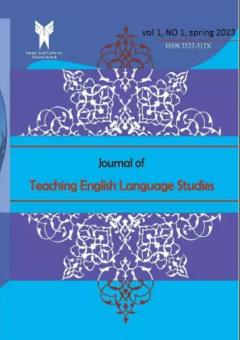A Comparative Study of the Effects of the Diglot Weave Technique (DWT) and Project-Based Learning (PBL) on Iranian EFL Learners’ Knowledge of Idioms
الموضوعات : نشریه مطالعات آموزش زبان انگلیسیRamin Rahmany 1 , Marzieh Semyari 2
1 - Department of English Language, Takestan Branch, Islamic Azad University, Takestan, Iran
2 - Department of English Teaching, Islamic Azad University E-Campus, Islamic Azad University, Iran
الکلمات المفتاحية: Comparative Study, DWT, PBL, EFL Learners, Knowledge of Idioms,
ملخص المقالة :
The acquisition of idiomatic expressions is a significant component of acquiring proficiency in a foreign language. According to Richards and Rodgers (2001), this factor connects the four essential language skills: speaking, listening, reading, and writing. The importance of acquiring idioms is becoming more well-recognized in language learning. Nevertheless, there exists a considerable divergence of opinion regarding the efficacy of various methodologies employed in the presentation of vocabulary items. Furthermore, the acquisition of idiomatic expressions is sometimes regarded as a monotonous and arduous undertaking. There has been a significant shift in perspectives regarding the essence of idioms. However, there is a requirement to enhance the approaches employed in the generation of idioms. Considerable focus has been directed toward the examination of teachers' utilization of both the target language and the first language within the educational setting. Teachers commonly employ code-switching between the first language and the target language as a pedagogical strategy to facilitate the transition from familiar linguistic territory (the first language) to unfamiliar linguistic terrain (the target language). The purpose of this study is to help instructors introduce the diglot weave technique, and project-based learning to students to expand their receptive and productive knowledge of idioms systematically because in EFL contexts, learners often encounter problems in receptive and productive knowledge of idioms. Therefore, this study aims to investigate the effects of the diglot weave technique (DWT), and project-based learning on Iranian EFL learners’ receptive and productive knowledge of idioms.
Aggarwal, R., & Zhan, X. (2016). Project Based Learning for K-12: A Practical Guide for Teachers. Solution Tree Press.
Bell, S. (2010). Project-Based Learning for the 21st Century: Skills for a Changing World. Solution Tree Press.
Boers, F., Decoo, J., & Eyckmans, J. (2016). Phraseological competence in L2 learners: A matter of course? Bilingualism: Language and Cognition, 9(1), 88-112.
Boss, S., & Krauss, S. (2014). Project Work & Collaborative Learning in Teacher Education. Routledge.
Chiang, Y. H., & Lee, Y. H. (2016). The effects of project-based learning with technology integration on students' learning motivation and problem-solving skills. Journal of Computers in Education, 3(4), 417-434.
Creswell, J. W. (2018). Research Design: Qualitative, Quantitative, and Mixed Methods Approaches (5th ed.). SAGE Publications.
Dimmitt, M. J. (2017). A project-based learning approach to teaching and learning critical thinking skills in teacher education programs. Journal of Teacher Education, 68(5), 483-494.
Duffy, T. M., & Cunningham, J. L. (2020). Unterricht und Lerntheorien: Integration in der Praxis (9th ed.). Cornelsen Verlag. (Original work published 1996)
Elliott, S. N. (2020). Project-Based Learning in the Elementary Grades. Routledge.
Erdogan, N., & Senemoglu, N. (2017). The effects of project-based learning on students' science process skills and problem-solving skills. Educational Sciences: Theory and Practice, 17(6), 1429-1441.
Freeman, D. (2018). Teacher code-switching: Classroom applications. Routledge.
Habók, V., & Nagy, W. (2016). Teaching idioms through storytelling activities. Reading & Writing Quarterly, 32(1), 187-212.
Han, S., Kim, Y., & Kim, Y. M. (2016). Project-based learning for fostering students' higher-order thinking skills and academic performance: A case study in a science classroom. Journal of Educational Psychology, 108(6), 773-785.
Imafuku, M., Inanaga, S., & Katagiri, Y. (2014). The effects of project-based learning on students' academic performance and collaboration skills. The Asia-Pacific Journal of Quality Education, 3(4), 19-32.
Larsen-Freeman, D. (2013). Teaching language acquisition. Heinle & Heinle.
Lewis, M. (1993). The lexical acquisition hypothesis. Language Acquisition, 1(1), 1-33.
Means, B. (2013). Learning to read in the digital age. Heinemann.
Oskuee, M. K., Pustchi, F. S., & Salehpour, M. R. (2012). The effect of using cartoons on Iranian EFL learners’ comprehension of English idioms. Journal of Language Teaching and Research, 3(2), 339-352.
Pie, R. (2008). The benefits of code-switching in the L2 classroom. International Journal of Multilingual Development, 29(4), 347-360.
Richards, J. C., & Rodgers, T. S. (2001). Psychological approaches to language learning. Cambridge University Press.
Si, T. (2019). The challenges of teaching EFL learners’ idioms in Chinese context. Journal of Language Teaching and Research, 10(2), 33-40.es
Underwood, M. (2017). Project work & collaborative learning in teacher education. Routledge.
Van Lier, L. (2008). Interaction in language learning: Awareness, form, and function. Cambridge University Press.
Yazan, O. M. (2015). The challenges faced by Yemeni EFL learners in understanding and using English idioms. International Journal of English Language Education, 3(2), 50-57.


